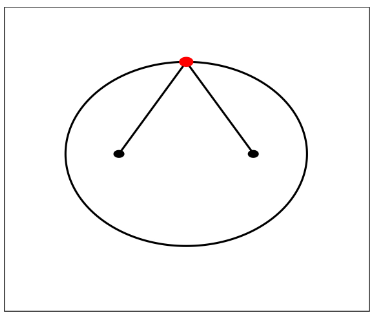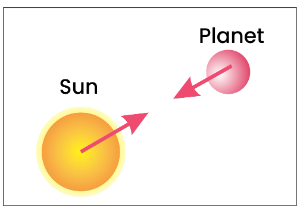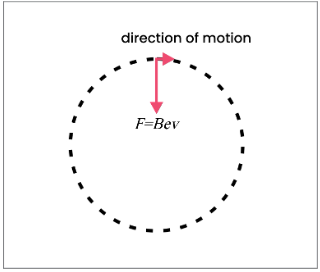Orbits
What are Orbits?
In theory, the motion of a planet around a star can be circular, which is known as circular motion. However, in practice, planets follow an elliptical path that has two focal points.
The constant sum of the distances between any point on an ellipse and its foci is a well-known fact. Planetary orbits have the sun as one of their foci. As a planet approaches its star, it gains speed because of the conversion of gravitational potential energy into kinetic energy. Additionally, it is important to note that a circle is a special type of ellipse where both foci are located at the same point.

What is Kepler’s Third law?
Kepler’s third law states that:
“The square of the orbital period of a planet is directly proportional to the cube of the semi-major axis of its orbit.“
The third law of Kepler states that there is a direct proportionality between the square of a planet’s orbital period and the cube of the semi-major axis of its orbit. This law can be mathematically represented as T^2 = k*a^3, where T is the orbital period, a is the semi-major axis, and k is a constant that varies depending on the mass of the central star.
The third law of Kepler is a crucial principle in the study of planetary motion and serves as a basis for calculating the distances between planets and stars. It was established in the early 17th century by the German astronomer Johannes Kepler, who derived it from the observations of the Danish astronomer Tycho Brahe.
What are Circular Orbits and its connection to the solar system?
From a view above the North Pole, the direction of motion for all planets within the Solar System is counterclockwise.
As a planet moves further away from the Sun, its speed in orbit decreases. Despite the elliptical shape of planetary orbits, most planets have nearly circular orbits, allowing us to apply our knowledge of circular motion to describe their motion.
The vacuum of space does not provide any resistance to planetary motion as they move through it; only gravitational forces have an effect on them. The attraction between a planet and the Sun creates an unbalanced force that produces the centripetal acceleration required for planetary motion.
The illustration depicts the attractive forces that exist between a planet and the Sun.

According to the diagram, the gravitational force on a planet is directed towards the center of mass of the Sun, acting upon the planet’s center of mass.
What is the Force on the planet?
The main force acting on a planet is the gravitational attraction between the planet and its orbiting star. This force is identified as the centripetal force and is responsible for maintaining the planet’s motion in its orbit around the star.
The force’s magnitude is determined by the masses of the planet and its star, as well as the distance separating them. Newton’s law of universal gravitation states that the force is proportional to the product of their masses and inversely proportional to the square of the distance between them. As a result, the force exerted on the planet decreases as the distance between the planet and its star increases.
What are Satellites?
The relationship between a planet’s radius and its orbital velocity can be applied to calculate the speed of a satellite orbiting around the Earth.
Substituting the mass of the Earth (ME) for the mass of the Sun (Ms) in the equation enables us to calculate the velocity of a satellite at any orbital radius around the Earth.
What are Geo Synchronous Orbits?
A geosynchronous orbit refers to a circular path around the Earth where a satellite completes one full orbit in almost the same duration as the Earth takes to complete one rotation on its axis, which is about 24 hours. As a result, the satellite seems to remain fixed in the sky relative to a fixed point on the Earth’s surface.
Geosynchronous orbits are advantageous for communication and weather satellites as they permit a stable connection with a specific spot on the Earth’s surface. The geosynchronous orbit’s altitude is roughly 36,000 kilometers (22,236 miles) above the Earth’s equator.
A geostationary orbit is a type of orbit that is a variation of a geosynchronous orbit. It is characterized by having zero inclination to the Earth’s equator and allows a satellite to remain fixed over the same point on the Earth’s equator. This orbit is particularly useful for communications and weather satellites.
What are Circular Orbits in magnetic fields?
When a charged particle moves perpendicular to a magnetic field, it undergoes a magnetic force that acts perpendicular to both the magnetic field and the direction of motion of the particle. This force can cause the particle to move in circular motion around the magnetic field.
The illustration depicts the trajectory and the magnetic force acting on an electron as it moves in a magnetic field that points towards the back of the page.

To apply Fleming’s rule to electrons, it is important to note that the direction of current is opposite to the direction of electron motion.
An orbit is the path that an object takes as it travels around another object in space, under the influence of gravity.
The shape of an orbit depends on the gravitational force acting on the object and its initial velocity. If the object has enough velocity to escape the gravitational pull of the object it is orbiting, it will follow a parabolic or hyperbolic path. If the object does not have enough velocity to escape, it will follow an elliptical path.
An elliptical orbit is a type of orbit where the path of the object is an ellipse, with the object traveling closer to the object it is orbiting at some points (called periapsis) and farther away at others (called apoapsis).
A circular orbit is a type of orbit where the path of the object is a perfect circle, with the object traveling at a constant distance from the object it is orbiting.
A geostationary orbit is a type of circular orbit that is positioned directly above the Earth’s equator and has a period of 24 hours. This means that the object in the orbit appears to be stationary from the perspective of an observer on the Earth’s surface.
A satellite is an object that is placed in orbit around another object, while a space probe is a spacecraft that is sent to explore space beyond Earth’s orbit.
Kepler’s first law of planetary motion states that the orbit of a planet around the sun is an ellipse, with the sun at one of the foci of the ellipse.
Kepler’s second law of planetary motion states that the line joining a planet to the sun sweeps out equal areas in equal times. This means that a planet moves faster when it is closer to the sun and slower when it is farther away.
Newton’s law of universal gravitation states that every object in the universe attracts every other object with a force that is proportional to the product of their masses and inversely proportional to the square of the distance between them.
The force of gravity acts as a centripetal force that keeps an object in orbit. The speed of the object in the orbit and the distance from the object it is orbiting determine the strength of the gravitational force and therefore the shape and stability of the orbit.





Still got a question? Leave a comment
Leave a comment